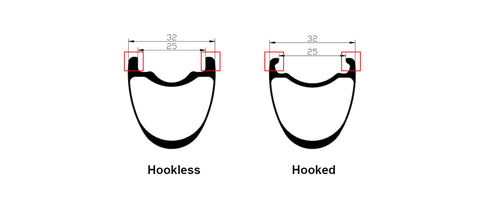The Ultimate Guide to Hooked vs Hookless Bicycle Rims - Differences, Compatibility and Uses
A safe and comfortable ride depends on the correct bicycle rim being chosen. When choosing a rim, one should consider tire type, riding style, and fit with the bike and tire configuration. Both hooked and hookless rims are two often used styles for bicycle rims; each has benefits and drawbacks. Hookless rims are simpler to install and give higher impact resistance, even if hooked rims offer extra mechanical lock and security. Moreover, the hybrid hook design offers a larger maximum pressure limit and a smoother change from the tire to the rim, therefore combining the advantages of both types. Your riding need, tire type, and preferred running pressure will ultimately determine whether hooked or hookless rims are best for you.
Difference Between Hooked and Hookless Rim
A hooked rim and a hookless rim are two different designs commonly found in bicycle rims, particularly in relation to tubeless-ready rims. The main difference lies in the way the tire bead is retained on the rim.

1. Hooked Rim:
A hooked rim has a pronounced inward-facing hook or flange on the inner edge of the rim sidewall. This hook helps secure the tire bead in place and prevents it from coming off the rim, especially at high pressures. Traditionally, most rims were designed with hooks to accommodate clincher tires (tires with inner tubes), as the hook provided a reliable mechanical lock.
2. Hookless Rim:
As the name implies, a hookless rim is devoid of the clear hook or flange on the inner edge of the rim. Rather, it has a straight sidewall profile devoid of an inward-facing hook. The tire bead engages the rim firmly by depending on an exact fit and air pressure. Usually made for tubeless configurations, hookless rims let the tire create an airtight seal against the rim bed without an inner tube.
Important variations between hooked and hookless rims consist in:
Because of the hook, hooked rims usually demand extra work to mount or detach the tire. Conversely, hookless rims often provide a more forgiving tire installation technique.
Particularly at high pressure, hooked rims offer an extra mechanical lock with the tire bead pressed against the hook, therefore providing more security. Along with air pressure to retain the bead, hookless rims depend on a closer fit between the tire bead and the rim bed.
Impact Resistance: To offset the lack of the hook, hookless rims sometimes have a more solid construction with thicker sidewalls. This design increases the impact resistance and lifetime of the rim.
Generally speaking, hooked rims fit both tubeless tires (with sealant) and clincher tires (with inner tubes). Mostly intended for tubeless configurations, hookless rims are meant to help to maintain tires with inner tubes by lacking a hook.
3. Hybrid Hook Rim
The Hybrid Hook design combines hooked and hookless wheel benefits. This design gives a little aerodynamic edge over conventional hooked wheels by almost matching the smoothness of the tire to the rim. Furthermore, the maximum pressure restriction for hybrid hook wheels is around five psi higher than for our hookless wheels; hence, tire blowoff risk is much lowered.
Who is Hooked Rim for?
Many road riders who give performance top priority are reluctant to change to hookless rims because of tire compatibility and pressure restrictions. For individuals who run over 72 psi or have tires less than 5mm wider than the rim, hookless rims are not appropriate. Hookless rims could be a suitable fit for you if you prioritize aerodynamic improvements and primarily travel on calmer routes. If you intend to run high pressure, though, then for now a hooked rim is a safer option.
Who is Hookless Rim for?
Many cyclists have turned to lower-pressure, larger-volume tires. A lighter and somewhat more reasonably priced alternative, hookless rims can simplify the setup procedure, improve safety, give more impact protection at lower pressures, and be a superior choice overall.
Although hookless rims have long been used on mountain bikes, it is crucial to remember that mountain biking has somewhat different needs than road riding. Designed to be lighter and wider, mountain bike rims have edges built to resist impact rather than be aerodynamic. Mountain bike tires also call for a far lower inflation pressure and are stiffer. Among the various advantages the lower pressure provides are less risk of blow-off. Hookless is the better choice if you are purchasing mountain bike wheels.
Can I use hookless tires on hooked rims?
All tubeless-ready tires are compatible with hooked rims.
Maximum tire pressure
Many rim and tire makers have discovered that hooks greatly raise the pressure at which a tire stays safe and secure on a rim. Whereas hookless road rims have a maximum of 75 psi (55 psi for gravel rims), hooked road rims have a tire pressure limit of 115 psi (60 psi).
